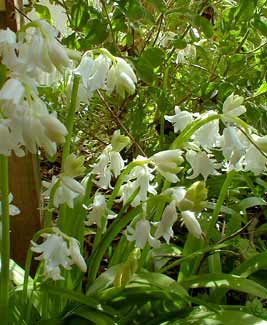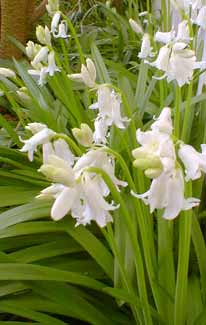
White English Squill
"Here grows a white, white flower
By the wild Alps of romance;
And who would reach its dainty leaves
Takes life & death in chance."
-Frank Wilmot
(1881-1942)
(1881-1942)
Hyacinthoides hispanica 'Alba' besides duplicating its bulbs rapidly, also seeds itself. The seeds grow true to the parent plant, eventually covering broad areas with lily turf which in late March & throughout April & a little ways into May send up dangly racemes of white flowers.
It requires almost no attention & can be grown in the crummiest locations. We actually never planted any of this, it was already in the yard, & could well be considered a bit invasive, restricted only by its unwillingness to spread into direct sunlight.
It has planted itself in several dry, shady, unreachable locations right up against the foundation of the house & behind big shrubs, places where I wouldn't've intentionally planted anything in any case, so its welcome to as much of that space as it wants.
It's nice to see so many blooms in places where otherwise even weeds won't grow. If it really did annoy anyone that it naturalizes so well, it is not that hard to get rid of if it with a little digging. I do occasionally remove it from places where I don't want it, potting the spares to give away.
 In our yard the white-flowering squills bloom two or three weeks ahead of the blue ones. Since both the whites & the blues seem to have been naturalized in the gardens for decades, it is interesting to see that the white ones have self-selected areas of deepest shade & spread into other shady areas, while the blue-flowering squills have chosen areas of dappled sunlight & when they crop up at any distance it will always be in a semi-shade or semi-sunny area.
In our yard the white-flowering squills bloom two or three weeks ahead of the blue ones. Since both the whites & the blues seem to have been naturalized in the gardens for decades, it is interesting to see that the white ones have self-selected areas of deepest shade & spread into other shady areas, while the blue-flowering squills have chosen areas of dappled sunlight & when they crop up at any distance it will always be in a semi-shade or semi-sunny area.Both the blues & whites have self-selected dry locations deep underneath shrubs or up against the house, but 'Alba' is most extreme in spreading along the foundation so far back under the eaves that even rainfall only occasionally reaches it. So the Whites & the Blues are not directly competing with each other.
The top photo, taken early in April, shows the White Squill all bushed out with daggery-turf &, jam-packed with blossoms, growing at the foot of an enormous Forsythia which permits very little light through to the ground & sucks up all moisture for itself. This area goes largely unwatered; what rainfall reaches it is sucked up by the forsythia & by another big shrub, Ed Goucher's Abelia, the root crown of which is likewise surrounded by white squills throughout late March & April.
The second photo snapped in March shows another patch that seeded itself right against the wall. I planted some Sweet Woodruff back there because that's a plant that likes shade & is regarded as so adaptable it can even become troublesomely invasive. But after four years the Sweet Woodruff is still thin, not really liking the harsh dry soil conditions that just thrill the white squill no end.
This fondness for dry deep shade seems to be peculiar to the white only, since they have self-seeded only in dryer darker locations, whereas the blue English Bluebells & the blue Spanish bluebells have migrated through dappled sunlight along with the grape hyacinths, never into the deepest shade areas dominated by naturalized whites.
Both the White & the Blue (here in the Northwest's Zone 8 at least) appear to prefer locations considerably drier than most of the books suggest they require, & a tendency to spring up hard against the house's foundation farthest under the eaves suggests to me they have an active dislike for wetter spots which they've assiduously avoided. When a white squill pops up in a damp location, it is never as a thick patch & does not bloom as intensely.